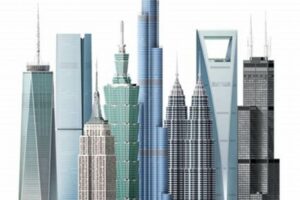Skyscrapers are designed to withstand high winds and earthquakes, but they do sway. The amount of sway depends on the height and design of the building, as well as the wind speed and direction.
The tallest buildings in the world can sway several feet in high winds. For example, the Burj Khalifa, the tallest building in the world, sways about 6 feet (1.8 meters) in high winds. This may not seem like much, but it is enough to be noticeable to people inside the building.
Swaying can be a problem for people who are afraid of heights or who have motion sickness. However, it is important to remember that swaying is a normal part of a building’s design and does not pose a safety hazard.
1. Height
Height is one of the most important factors that affects how much a skyscraper sways. The taller a building is, the more it will sway in high winds. This is because the wind has more leverage to push a taller building back and forth.
- The Burj Khalifa, the tallest building in the world, sways about 6 feet (1.8 meters) in high winds.
- The Empire State Building, which is about half the height of the Burj Khalifa, sways about 3 feet (0.9 meters) in high winds.
- A 10-story building might only sway a few inches in high winds.
The height of a building also affects how it is designed to resist swaying. Taller buildings need to have stronger structural systems and more damping systems to keep them from swaying too much.
2. Design
The design of a skyscraper is another important factor that affects how much it sways. Buildings with a symmetrical design are more resistant to swaying than buildings with an asymmetrical design. This is because the wind forces are more evenly distributed on a symmetrical building.
The shape of a building also affects how much it sways. Buildings with a streamlined shape are more resistant to swaying than buildings with a boxy shape. This is because the wind can flow more easily around a streamlined building.
The materials used to construct a building also affect how much it sways. Buildings made of lightweight materials, such as steel and aluminum, are more likely to sway than buildings made of heavier materials, such as concrete and stone.
The design of a building’s structural system also affects how much it sways. Buildings with a strong structural system are more resistant to swaying than buildings with a weak structural system.
The design of a building’s damping systems also affects how much it sways. Damping systems are devices that help to absorb energy from the wind and reduce swaying.
The design of a skyscraper is a complex process that takes into account many factors, including how much the building is likely to sway in high winds.
3. Wind speed
Wind speed is one of the most important factors that affects how much a skyscraper sways. The stronger the wind, the more a skyscraper will sway. This is because the wind exerts a force on the building, pushing it back and forth. The taller a building is, the more force the wind will exert on it, and the more it will sway.
- Steady wind
A steady wind is a wind that blows at a constant speed and direction. Steady winds are the most common type of wind, and they are the type of wind that skyscrapers are designed to withstand.
- Gusts
A gust is a sudden increase in wind speed. Gusts can be caused by a variety of factors, such as changes in the weather or the terrain. Gusts can be dangerous for skyscrapers, as they can cause the building to sway suddenly and unexpectedly.
- Vortices
Vortices are swirling columns of air that can form around tall buildings. Vortices can cause the building to sway back and forth, and they can also cause the building to vibrate.
- Resonance
Resonance is a phenomenon that occurs when a building’s natural frequency matches the frequency of the wind. When resonance occurs, the building will sway more violently than it would if it were not in resonance. Resonance can be a dangerous phenomenon, as it can cause the building to collapse.
Skyscrapers are designed to withstand high winds, but they can still sway significantly in strong winds. The amount of sway depends on the wind speed, the height of the building, and the design of the building.
4. Wind direction
Wind direction is another important factor that affects how much a skyscraper sways. The wind exerts a force on the building, pushing it back and forth. The direction of the wind determines which side of the building is being pushed, and how much it sways.
For example, a skyscraper that is facing directly into the wind will sway more than a skyscraper that is facing away from the wind. This is because the wind has more force to push against the building when it is facing directly into it.
Skyscrapers are designed to withstand high winds from any direction. However, the wind direction can still affect how much the building sways. Engineers take wind direction into account when designing skyscrapers, and they make sure that the building is strong enough to withstand winds from any direction.
5. Damping systems
Damping systems are devices that help to absorb energy from the wind and reduce swaying. They are an important component of skyscrapers, as they help to keep the buildings safe and comfortable for occupants.
There are a variety of different types of damping systems, but they all work on the same basic principle. They absorb energy from the wind by converting it into heat or other forms of energy. This helps to reduce the amount of energy that is transferred to the building, and it reduces the amount of swaying.
Damping systems are an essential part of skyscrapers. They help to keep the buildings safe and comfortable for occupants, and they can also reduce the amount of damage that is caused by high winds.
6. Resonance
Resonance is a phenomenon that occurs when a building’s natural frequency matches the frequency of the wind. When resonance occurs, the building will sway more violently than it would if it were not in resonance. Resonance can be a dangerous phenomenon, as it can cause the building to collapse.
Skyscrapers are designed to withstand high winds, but they can still be affected by resonance. In fact, some of the tallest skyscrapers in the world have been designed to sway in order to avoid resonance.
One example of a skyscraper that has been designed to sway is the Burj Khalifa. The Burj Khalifa is the tallest building in the world, and it is designed to sway up to 6 feet (1.8 meters) in high winds. This swaying helps to reduce the amount of stress on the building’s structure and prevents the building from collapsing.
Resonance is a serious consideration for skyscraper designers. By understanding the concept of resonance, engineers can design skyscrapers that are safe and to high winds.
7. Occupant comfort
Occupant comfort is an important consideration in the design of skyscrapers. Occupants of skyscrapers can be affected by a variety of factors, including swaying.
Swaying can cause discomfort for occupants, especially for those who are afraid of heights or who have motion sickness. Swaying can also interfere with activities such as working, eating, and sleeping.
To ensure occupant comfort, engineers must carefully consider the amount of sway that is likely to occur in a skyscraper. They can use a variety of techniques to reduce sway, such as using damping systems and designing the building to be more aerodynamic.
One example of a skyscraper that has been designed to minimize sway is the Burj Khalifa. The Burj Khalifa is the tallest building in the world, and it is designed to sway up to 6 feet (1.8 meters) in high winds. This swaying helps to reduce the amount of stress on the building’s structure and prevents the building from collapsing.
Occupant comfort is an important consideration in the design of skyscrapers. By understanding the connection between occupant comfort and swaying, engineers can design skyscrapers that are safe and comfortable for occupants.
8. Safety
Safety is a paramount consideration in the design and construction of skyscrapers. One important aspect of safety is ensuring that the building can withstand high winds without swaying excessively. Excessive swaying can cause discomfort for occupants, damage to the building, and even collapse in extreme cases.
The amount that a skyscraper sways is influenced by a number of factors, including the height of the building, the design of the building, and the wind speed. Taller buildings and buildings with a more slender design are more likely to sway more than shorter buildings and buildings with a more boxy design. Additionally, higher wind speeds will cause a building to sway more than lower wind speeds.
Engineers use a variety of techniques to reduce the amount of sway in skyscrapers. These techniques include using damping systems, which are devices that absorb energy from the wind and reduce swaying, and designing the building to be more aerodynamic.
By understanding the connection between safety and how much skyscrapers sway, engineers can design and construct skyscrapers that are safe and comfortable for occupants.
9. Perception
The perception of how much skyscrapers sway can vary depending on a number of factors, including the individual’s height, weight, and familiarity with skyscrapers. People who are afraid of heights may perceive skyscrapers to sway more than people who are not afraid of heights. Similarly, people who are heavier may perceive skyscrapers to sway more than people who are lighter. Additionally, people who are familiar with skyscrapers may perceive them to sway less than people who are not familiar with skyscrapers.
- Visual cues
People rely on visual cues to perceive the movement of objects. When looking at a skyscraper, people may use the horizon as a reference point to judge how much the building is swaying. However, the horizon is not always a reliable reference point, as it can be difficult to see in certain weather conditions. Additionally, the horizon may appear to move if the person is moving, which can make it difficult to judge how much the skyscraper is actually swaying.
- Vestibular cues
People also rely on vestibular cues to perceive the movement of objects. The vestibular system is located in the inner ear and it helps people to maintain their balance. When the vestibular system detects movement, it sends signals to the brain, which interprets the signals and produces a sense of movement. In the case of skyscrapers, the vestibular system may detect movement even if the person is not actually moving. This can happen if the skyscraper is swaying in the wind, or if the person is moving inside the skyscraper.
- Cognitive factors
Cognitive factors can also influence the perception of how much skyscrapers sway. For example, people who are anxious or stressed may be more likely to perceive skyscrapers as swaying more than people who are calm and relaxed. Additionally, people who have had a negative experience with skyscrapers, such as being in a skyscraper during an earthquake, may be more likely to perceive skyscrapers as swaying more than people who have not had a negative experience with skyscrapers.
- Cultural factors
Cultural factors can also influence the perception of how much skyscrapers sway. For example, in some cultures, it is considered to be a sign of strength and stability to be able to stand in a tall building without feeling dizzy. In other cultures, it is considered to be a sign of weakness to be afraid of heights. These cultural factors can influence how people perceive the movement of skyscrapers.
The perception of how much skyscrapers sway is a complex process that is influenced by a number of factors. By understanding these factors, engineers and architects can design skyscrapers that are not only safe and structurally sound, but also visually appealing and comfortable for occupants.
FAQs on How Much Skyscrapers Sway
Skyscrapers are designed to withstand high winds and earthquakes, but they inevitably sway to some degree. Here are answers to some frequently asked questions about how much skyscrapers sway and the factors that affect it:
Question 1: How much do skyscrapers sway?
The amount that a skyscraper sways depends on several factors, including the height and design of the building, as well as the wind speed and direction. Taller and more slender buildings tend to sway more than shorter and more boxy buildings. In high winds, the tallest buildings in the world can sway several feet.
Question 2: Is it safe to be in a skyscraper that is swaying?
Yes, it is safe to be in a skyscraper that is swaying. Skyscrapers are designed to withstand high winds and earthquakes, and they sway to absorb energy from the wind. This swaying helps to protect the building and its occupants from damage.
p>
Question 3: Can people feel skyscrapers swaying?
Yes, people can feel skyscrapers swaying, especially in taller buildings or during high winds. However, the swaying is typically not noticeable to people who are not paying attention to it.
Question 4: What are some of the factors that affect how much a skyscraper sways?
The height, design, and location of a skyscraper can all affect how much it sways. Taller and more slender buildings tend to sway more than shorter and more boxy buildings. Buildings located in areas with high winds are also more likely to sway.
Question 5: Are there any buildings that are designed not to sway?
No, there are no buildings that are completely immune to swaying. However, some buildings are designed to sway less than others. These buildings typically have a more aerodynamic design and are equipped with damping systems to absorb energy from the wind.
Question 6: What happens if a skyscraper sways too much?
If a skyscraper sways too much, it can cause discomfort for occupants and damage to the building. In extreme cases, a skyscraper that sways too much can collapse. However, this is very rare, and skyscrapers are designed to withstand even the strongest winds.
Skyscrapers are an impressive feat of engineering, and they are designed to withstand even the strongest winds. While it is true that skyscrapers sway, this swaying is typically not noticeable to occupants and does not pose a safety hazard.
Transition to the next article section:
The next section of this article will discuss the design and construction of skyscrapers. We will explore the different types of materials used in skyscraper construction and the engineering techniques used to make skyscrapers safe and stable.
Tips for Understanding How Much Skyscrapers Sway
Skyscrapers are designed to withstand high winds and earthquakes, but they inevitably sway to some degree. Here are some tips for understanding how much skyscrapers sway and the factors that affect it:
Tip 1: Consider the height and design of the building. Taller and more slender buildings tend to sway more than shorter and more boxy buildings.
Tip 2: Pay attention to the wind speed and direction. Higher wind speeds and winds that are blowing directly into the side of a building will cause it to sway more.
Tip 3: Look for damping systems. Damping systems are devices that absorb energy from the wind and reduce swaying. Buildings with damping systems will sway less than buildings without damping systems.
Tip 4: Be aware of your own perception. The perception of how much a skyscraper sways can vary depending on the individual’s height, weight, and familiarity with skyscrapers.
Tip 5: Remember that swaying is normal. Skyscrapers are designed to sway, and it is not a sign of structural weakness. In fact, swaying helps to protect the building from damage in high winds.
Summary of key takeaways or benefits:
- By understanding the factors that affect how much skyscrapers sway, you can better appreciate the engineering that goes into these structures.
- Skyscrapers are designed to sway, and it is not a sign of structural weakness. In fact, swaying helps to protect the building from damage in high winds.
- If you are concerned about how much a skyscraper is swaying, you can look for damping systems or other features that help to reduce swaying.
Transition to the article’s conclusion:
Skyscrapers are an impressive feat of engineering, and they are designed to withstand even the strongest winds. While it is true that skyscrapers sway, this swaying is typically not noticeable to occupants and does not pose a safety hazard.
Conclusion
Skyscrapers are an impressive feat of engineering, and they are designed to withstand even the strongest winds. While it is true that skyscrapers sway, this swaying is typically not noticeable to occupants and does not pose a safety hazard.
The amount that a skyscraper sways depends on several factors, including the height and design of the building, as well as the wind speed and direction. Taller and more slender buildings tend to sway more than shorter and more boxy buildings. Buildings located in areas with high winds are also more likely to sway.
Skyscrapers are designed to sway to absorb energy from the wind. This swaying helps to protect the building and its occupants from damage. In fact, some skyscrapers are even designed to sway in order to avoid resonance, which is a phenomenon that can occur when the building’s natural frequency matches the frequency of the wind.
By understanding the factors that affect how much skyscrapers sway, we can better appreciate the engineering that goes into these structures. Skyscrapers are a testament to the ingenuity and creativity of human beings, and they continue to push the boundaries of what is possible in architecture.







